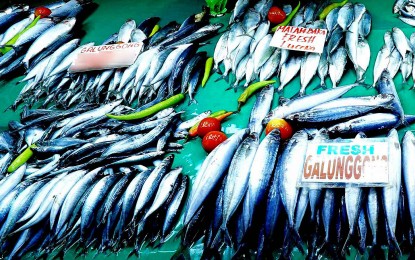
FRESH FISH. Fresh galunggong (round scad) are displayed in a Quezon City market on April 24, 2023. The Bureau of Fisheries and Aquatic Resources on Friday (April 26) confirmed that the country will import a lower volume of pelagic fish for the October 1 to December 21 closed fishing season. (PNA file photo by Ben Briones)
MANILA – The Bureau of Fisheries and Aquatic Resources (BFAR) on Friday confirmed a lower import volume of fish for the October to December closed fishing season.
In an interview, BFAR Spokesperson Nazario Briguera said the National Fisheries and Aquatic Resources Management Council (NFARMC) has decided to import 25,000 metric tons (MT) of frozen pelagic fish, including galunggong (round scad), mackerel, and bonito, among others.
Pelagic fish are those that inhabit the pelagic zone of the world’s lakes, rivers, and oceans - being neither close to the bottom nor near the shore. They range in size from small coastal forage fish, such as herrings and sardines, to large apex predator oceanic fishes, such as bluefin tuna and oceanic sharks.
The said importation, under Memorandum Order No. 17, shall cover the closed fishing season from October 1 to December 21 this year. The memorandum was issued shortly after President Ferdinand Marcos Jr. ordered the removal of non-tariff barriers on imported agricultural products under Administrative Order No. 20.
“Mas mababa ito kumpara doon sa inaprubahan noong nakaraang taon. Noong nakaraang taon, nasa 35,000 MT ang inaprubahan natin (This is lower compared to last year. Last year, we approved around 35,000 MT),” Briguera said.
He said the lower importation was made to match actual consumption, and supply from the country’s aquaculture sector.
In 2023, the 35,000 MT volume based on the certificate of necessity to import (CNI) was not fully consumed in terms of allocation, he noted.
“Minarapat ng konseho na dapat maging akma doon sa pangangailangan talaga, the actual consumption na nangyari noong umangkat tayo ng isda (The council decided that the actual consumption should match the import volume of fish),” Briguera said.
“Nagbigay din ng assurance ang ating aquaculture sector na magkakaroon sila ng sapat na volume din para mapunan kung ano man iyong gap (Our aquaculture sector also gave assurance that they have adequate supply to fill the gap),” he added.
Briguera, meanwhile, said that the early issuance of CNI will help avoid delays in the delivery of imports, citing some issues encountered in 2023.
“In terms of time, pag-process, iyong pagbiyahe nung mga inangkat na isda, nagkakaroon tayo ng issue (processing, and logistics, we had issues)," he said.
The said importation is also expected to help stabilize market prices once the closed fishing season is implemented in Palawan, Zamboanga Peninsula, and Davao Gulf. (PNA)
